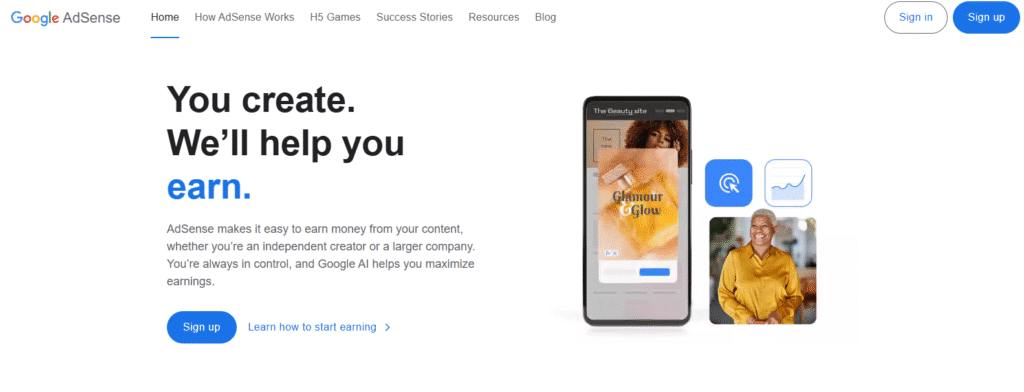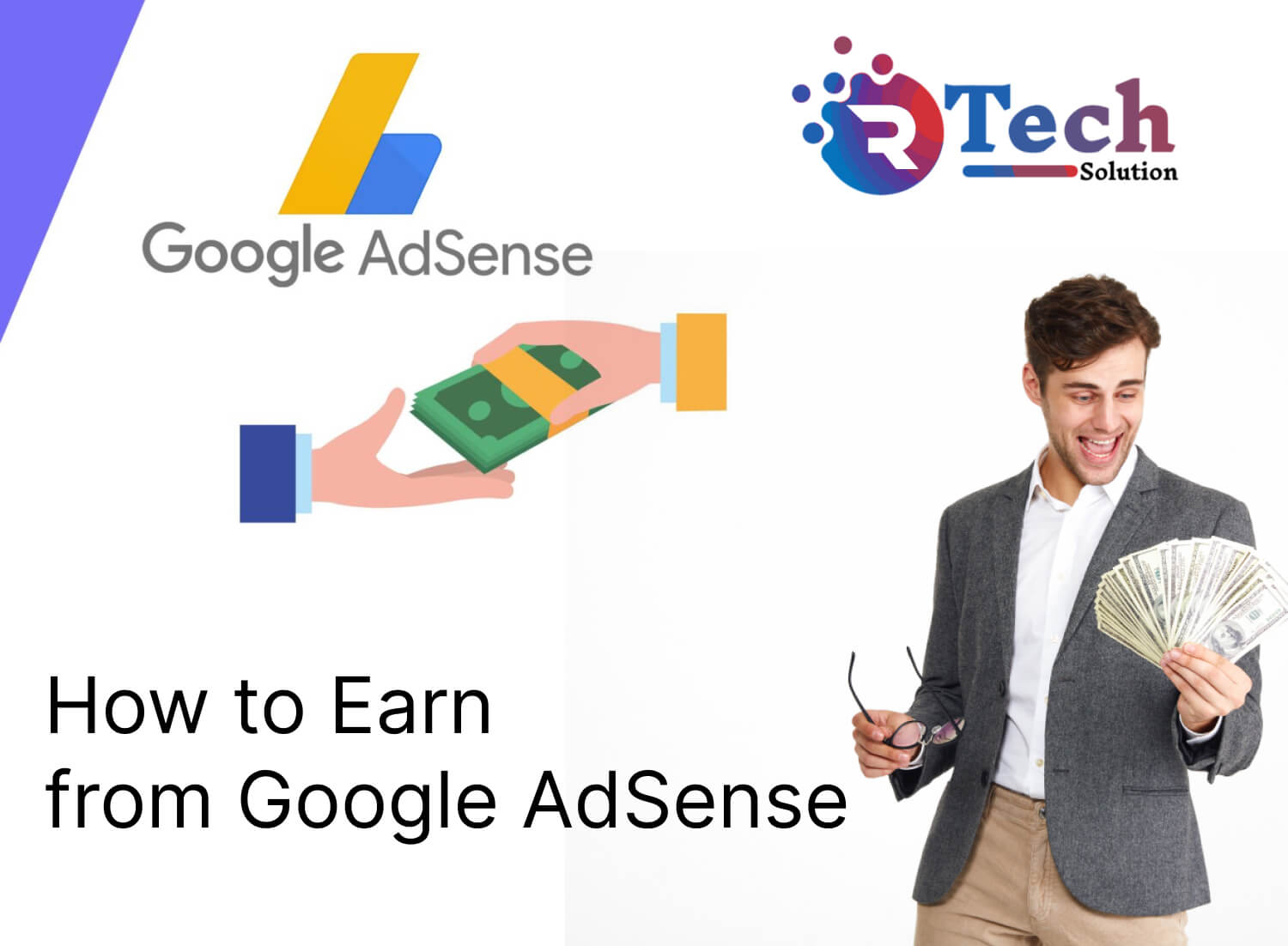You hit “publish,” refresh Analytics a few times, and wonder if those pageviews can do more than feed your ego. They can. Google AdSense has been the quiet, dependable way bloggers turn attention into income for nearly two decades. It isn’t a lottery ticket. It’s closer to a system: useful content → steady readers → respectful ad placement → repeat.
This guide is written the way we explain it to clients—clear steps, no hype, and room for your own judgment. It follows Google’s E-E-A-T principles (Experience, Expertise, Authoritativeness, Trustworthiness) so the advice reads like it came from practitioners, not a brochure.
What AdSense Actually Does (and what it doesn’t)

AdSense connects two sides of the web. On one side: businesses paying to run Google Ads. On the other: publishers like you with an audience. AdSense sits in the middle and places relevant ads on your pages. You earn from:
- CPC (cost per click): a reader clicks an ad.
- CPM (cost per thousand impressions): an ad is viewed, even if no one clicks.
It’s automated, which is why it scales. You write; Google auctions the space; money flows when the match is right. What AdSense doesn’t do: fix weak content, raise a slow site from the dead, or compensate for deceptive layouts. That part is on us.
AdSense vs Google Ads — quick clarity
People mix these up constantly:
- Google Ads: a tool for advertisers to buy traffic.
- Google AdSense: program for publishers to earn from that ad spend.
If you publish articles, you want an AdSense account (not a Google Ads account), though you might later use Google Ads to promote your own product or newsletter.
Should you apply yet? (Be honest here)
AdSense is more likely to say “yes” when your blog looks lived-in and helpful. A simple self-check:
- Original articles with substance (20–30+ posts is a healthy start).
- Clean navigation: obvious categories, search, no dead ends.
- Mobile-friendly layout and readable fonts.
- Trust pages: About, Contact, Privacy Policy, and (ideally) Editorial Policy.
- Consistent voice: write like a person with opinions and experience, not a glossary.
If your site feels like a weekend experiment, press pause, improve, then apply. It saves time and frustration.
E-E-A-T pre-flight: signals that build trust
Google’s human quality raters look for signs that a real person stands behind the content—especially on YMYL topics (money, health, legal). Do this:
- Experience: add author names, a short bio, and why you know this topic.
- Expertise: link to relevant work, talks, certifications, or case results.
- Authoritativeness: earn mentions, references, or quotes from reputable sites; keep your name consistent across platforms.
- Trustworthiness: HTTPS, visible contact details, revision dates, and a clear corrections policy.

These aren’t decoration. Readers feel them. Advertisers reward them.
How to apply (without tripping)
- Visit the AdSense site and sign up with your Google account.
- Add your domain and business details.
- Paste the verification code into your site’s <head> (or use your CMS integration).
- Submit for review.
- On approval, enable Auto ads or create manual ad units and place them where they make sense.
Approval ranges from two days to a couple of weeks. If it stalls, check speed, mobile layout, thin pages, and missing trust pages.

Where to place ads so readers don’t hate you
Good ad placement is quiet and obvious at the same time. Readers see it without feeling trapped.
- Above the fold: one responsive unit near the intro—after your first or second paragraph, not squashing the H1.
- In-article units: between sections of long posts. These perform well if the surrounding text genuinely answers a problem.
- Anchor ads (mobile): a slim bar that sits at the bottom without blocking content.
- Multiplex (grid) units: look like “more to read” modules; use sparingly.
- Sidebar (desktop): fine as a secondary spot; many themes hide sidebars on mobile, so don’t rely on them.
If your page reads like a billboard, you over-optimized. If readers scroll three screens before seeing an ad, you under-optimized. Find the line and stay on it.
The money math, without fairy dust
Three numbers matter in your AdSense dashboard:
- CPC — how much a click is worth.
- CTR — what percent of visitors click.
- RPM — revenue per 1,000 pageviews.
A quick, honest example (purely illustrative):
- 40,000 pageviews / month
- Average CPC ₹18, CTR 1.2% → 480 clicks → ₹8,640
- Add CPM earnings (say ₹60 RPM) → ₹2,400
- Estimated total ≈ ₹11,040 / month
Niche and geography swing this wildly. Finance, software, and B2B topics tend to pay more than general lifestyle. U.S./U.K. traffic usually outperforms many other regions.
How to raise earnings without breaking rules
1) Write for search intent, not word count
Answer the question people actually typed. Tutorials, checklists, comparisons, “things nobody tells you” posts—these keep readers on-page and make ads relevant.
2) Go long when it helps
Cornerstone guides (1,800–2,500 words) that cover steps, pitfalls, and tools age well. Update them quarterly; mark “Last updated” at the top.
3) Speed is non-negotiable
Compress images, lazy-load below-the-fold media, minimize layout shift. Faster pages mean more time on site, which quietly lifts RPM.
4) Let data nudge you
Use AdSense Experiments and A/B placements. A single ad moving 200px can outperform a redesign.
5) Internal links with purpose
Guide people to the next helpful page. It isn’t “SEO trickery”; it’s good hospitality.
6) Balance the page
If a paragraph and an ad are wrestling for space, the paragraph should win. Readers first. Revenue follows.
7) Build topical authority
Stick around one problem set long enough to be recognized. A blog that solves a family of related problems signals expertise better than a scatter of unrelated posts.
A short, practical case
A mid-size how-to site came to us with stable traffic but weak revenue. Pages looked nice; ads hid at the margins. We:
- Moved a single responsive in-article unit above the first subheading.
- Split dense paragraphs for breathing room and readability on mobile.
- Trimmed hero images to reduce CLS and improve speed.
- Rewrote three posts around user intent rather than brand terms.
Eight weeks later, RPM climbed from the ₹40–₹55 range to ₹100+. Same audience, calmer layout, clearer intent.
YouTube + AdSense (for the creators who do both)
If you also publish on YouTube, you can monetise there once the channel crosses the Partner Program thresholds. Link the channel to the same AdSense account; manage payouts in one place. Video and blog ads complement each other nicely when your topics line up.
If AdSense isn’t the right tool—today
Sometimes the match just isn’t there yet. Alternatives worth testing:
- Media.net (contextual, Yahoo/Bing).
- Ezoic (testing stack with machine-learning).
- Amazon Native Shopping Ads (product-heavy posts).
- Affiliate programs (often higher per-action payout).
- Your own product or service (courses, templates, consulting).
AdSense is a foundation, not a cage. Add layers as you grow.
Common mistakes (and the simple fix)
- Clicking your own ads / asking readers to click. That’s a ban.
- Ad-heavy above the fold. Your intro paragraph should breathe.
- Thin, generic content. Write something you’d bookmark.
- Forgetting mobile. Test with your thumbs, not just a mouse.
- No identity. Anonymous blogs struggle with trust; add names, faces, and a way to reach you.
The fix is usually boring: improve the page, then improve it again. It works.
FAQs
How long until approval?
Anywhere from 48 hours to two weeks. If it’s longer, check policy pages, speed, and the overall quality bar.
Do I need a traffic minimum?
No official number. A consistent flow of search traffic plus solid pages matters more than a single viral spike.
Can I run AdSense and affiliate links together?
Yes. Keep the layout clean and disclosures obvious.
What actually raises RPM fastest?
Better speed, one smart in-article placement, and content that answers intent without fluff.
Is AdSense free?
Yes. Your cost is the time and care to build something people want to read.
A quick blueprint you can repeat
- Pick a topic cluster you can write about with lived experience.
- Publish 10–15 genuinely useful posts—tutorials, mistakes to avoid, tools to try.
- Add trust pages and a short author bio.
- Apply for AdSense.
- Start with two placements: one near the intro, one mid-article.
- Fix speed issues; read your posts on a mid-range Android phone.
- Every month, update two older posts and publish two new ones.
- After three months, test a third placement or a different format. Measure. Keep what works.
It’s not fancy. It’s sustainable.
AdSense is quiet income when you respect the reader. Write like a person who has done the work and learned a few bruised-knee lessons along the way. Keep the site fast. Place ads where they belong. Tell the truth, even when it’s boring. That combination—experience, expertise, authority, trust—earns more than any trick ever will.
Maximizing Your ROI Best Practices for Google Ads Campaigns
About the author
The AR Infotech Solutions Editorial Team builds and grows websites for founders, educators, clinics, local retailers, and a fair number of stubborn tinkerers who love side projects. We write guides like this after launches, not before them. If you spot something we should clarify or update, tell us—we fix and credit.
This article is informational and reflects hands-on practice with website monetisation. Always follow Google’s latest policies and your local regulations.


